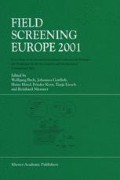Abstract
In building rubble recycling plants the incoming amount of building rubble and soil excavation is about the order of 2000 t per day. If the pollution burden of a delivery of rubble exceeds the threshold value determined by LAGA (’Länderarbeitsgemeinschaft Abfall’ Interstate study group on waste disposal) appropriate recycling is not allowed and the plant operator has to refuse acceptance. Similary, waste deliveries to normal waste disposal sites are only allowed to be deposited if the pollution thresholds for disposal sites are not exceeded. Therefore, if further treatment in recycling plants or in disposal sites is intended, the incoming building rubble should be classified into toxic waste, waste of disposable and of recycable quality. As classical analytical techniques cannot be carried out on-site with acceptable analysis time, waste samples suspected of being contaminated are usually transferred to an analytical laboratory for investigation, causing high costs and taking too much time. Therefore a screening analysis is demanded to rapidly characterize the content of toxic organic components in building rubble as aliphatic, monocyclic, chlorinated and polycyclic aromatic hydrocarbons within a few minutes only. Using a gas sensor system with the ability to discriminate gases in combination with thermal desorption of the organic pollutants out of the solid waste could be such a screening instrument.
Access this chapter
Tax calculation will be finalised at checkout
Purchases are for personal use only
Preview
Unable to display preview. Download preview PDF.
References
Althainz,P. (1996): Sensors and Actuators B, 33, 72–76
Althainz, P.;Dahlke, A.;Frietsch-Klarhof, M.; Goschnick, J.;Ache, H. J. (1995): Sensors and Actuators, B, 24–25, 366
Goschnick, J. (2000): To be published in Microelectronic Engineering, Proceedings of the Micro-and Nano-Engineering Conference, Jena, 18–21. September 2000
Author information
Authors and Affiliations
Editor information
Editors and Affiliations
Rights and permissions
Copyright information
© 2002 Springer Science+Business Media Dordrecht
About this chapter
Cite this chapter
Körber, R.W., Goschnick, J. (2002). Rapid Screening of Organic Pollutants in Rubble with an Electronic Nose Based on a Metal Oxide Gas Sensor Microarray. In: Breh, W., Gottlieb, J., Hötzl, H., Kern, F., Liesch, T., Niessner, R. (eds) Field Screening Europe 2001. Springer, Dordrecht. https://doi.org/10.1007/978-94-010-0564-7_25
Download citation
DOI: https://doi.org/10.1007/978-94-010-0564-7_25
Publisher Name: Springer, Dordrecht
Print ISBN: 978-94-010-3924-6
Online ISBN: 978-94-010-0564-7
eBook Packages: Springer Book Archive

